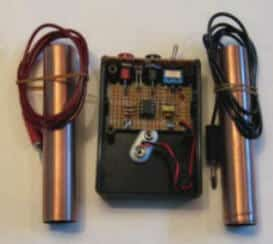TENS UNIT
CIDPUSA.org Guide Autoimmune diseases
Electrical treatments CIDPUSA
Transcutaneous Electrical Nerve Stimulation (TENS)

Transcutaneous electrical nerve stimulation (TENS)
is one of the most commonly used forms of electrostimulation for pain relief. Numerous clinical reports exist regarding the use of TENS for conditions such as low back pain, myofascial and arthritic pain, neurogenic pain, and postsurgical pain. The method of pain reduction produced by TENS is explained by the gate control theory proposed by Melzack and Wall in 1965. The "gate" between the level of the spinal cord and the pain centers of the brain usually is closed, thereby inhibiting constant nociceptive transmission by way of C fibers from the periphery to the T cell.
When painful peripheral stimulation does occur, the information carried by C fibers reaches the T cells and opens the gate, allowing pain transmission centrally to the thalamus and cortex, where it is interpreted as pain. Recall that the gate control theory postulated a mechanism by which the gate is closed again, preventing further central transmission of the nociceptive information to the cortex. The proposed mechanism for closing the gate is inhibition of the C-fiber nociception by impulses in activated myelinated fibers (eMedicine Clinical Knowledge Base, 1996; Gersh, 1992; Noback,1991).
A TENS unit consists of one or more electric signal generators, a battery, and a set of electrodes. The units are small and programmable, and the generators can deliver uninterrupted forms of stimuli with variable current strengths, pulse rates, and pulse widths. The preferred waveform is biphasic, which helps avoid the electrolytic and iontophoretic effects of a unidirectional current. A variety of newer transcutaneous or percutaneous electrical stimulation modalities are emerging as technology advances (Jarzem, 2005).
Interferential Current Therapy (IFC)
Interference current, utilized as interferential current therapy (IFC), is based on the summation of two alternating-current signals of slightly different frequency. This results in current having a recurring modulation of amplitude, based on the difference in frequency between the two signals.
When these signals are in phase, they sum to an amplitude sufficient to stimulate; when the signals are out of phase, no stimulation occurs. To determine the stimulation rate of an IFC unit, you must understand that the of IFC is equal to the difference in the frequencies of the two signals. For example, the beat frequency and, hence, the stimulation rate of a dual-channel IFC unit with signals set at 3400 and 3300 Hz is the difference of 100 Hz.
Interferential current therapy can deliver high currents compared to other stimulators, and can use 2, 4, or 6 applicators, arranged in either the same plane for use on regions such as the back or in different planes in complex regions such as the shoulder (eMedicine Clinical Knowledge Base, 1996; Gersh,1992).
Neuromuscular Electrical Stimulation (NEMS)Neuromuscular electrical stimulation (NMES) is the application of current to elicit a muscle contraction. The use of NMES in orthopedic and neuromuscular rehabilitation has grown significantly in recent years. A nerve action potential may be elicited either by a command originating in the motor cortex of the brain or by an electrically induced stimulus at the periphery. NEMS is addressed below under Stimulating Muscle Contraction.
Functional Electrical Stimulation (FES)Functional electrical stimulation (FES) is another form of electrotherapy that utilizes electrical currents to activate the nerves that serve extremities affected by paralysis. This paralysis can be the result of a spinal cord injury, head injury, stroke or other neurologic disorders. The goal of FES is to help restore function in people with disabilities. The many possibilities for patient management using FES are beyond the scope of this course. However, a description of the use of FES for normalizing gait pattern in included under Stimulating Muscle Contraction, below.